1.S&P 500 Trading Above 200Day for 5th Longest Streak Since 1993.
Charlie Bilello–The S&P 500 ETF ($SPY) has not closed below its 200-day moving average since May 2020. That’s the 5th longest streak since its inception in 1993.
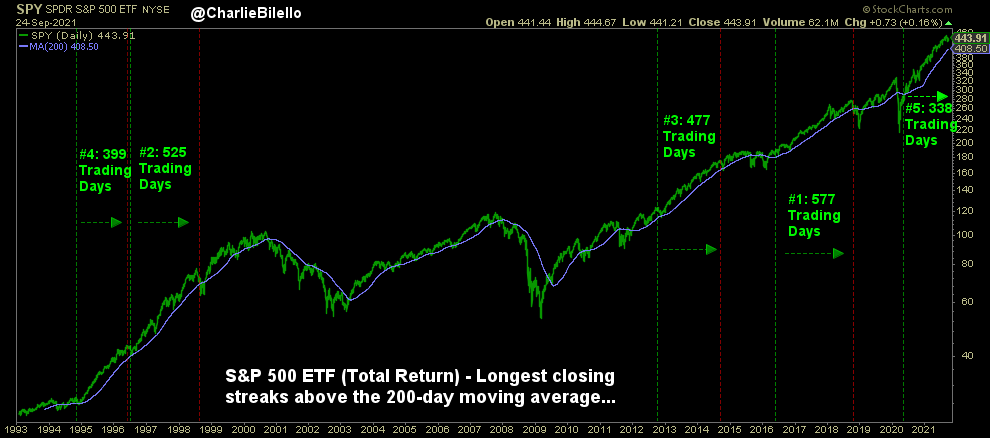
https://compoundadvisors.com/blog
2.Nasdaq 100 Tech vs. Russell 2000 Small Cap Yesterday………3% Spread in Performance.
Bloomberg
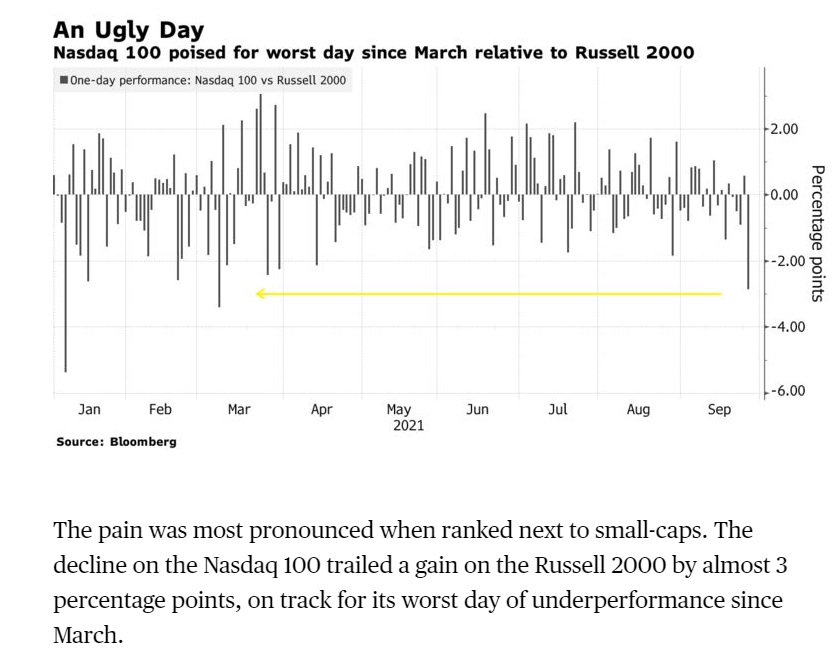
3.S&P 500 Companies Entering Black Out Period for Buybacks….80% of Companies by Mid-October.
From Dave Lutz at Jones Trading
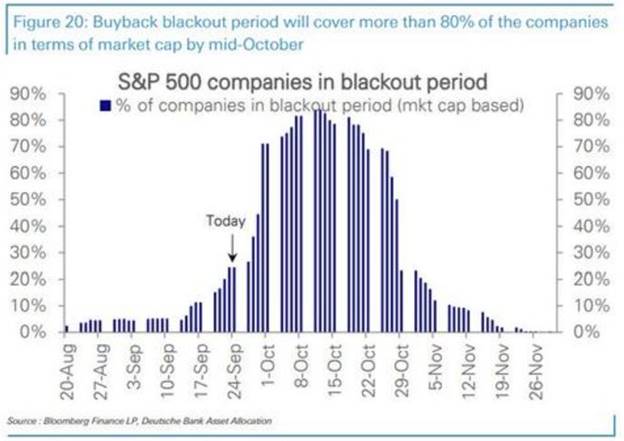
DB notes that the “Buyback Blackout” window is rapidly building..
4.U.S. Household Equity Allocation at Record=Low Returns Going Forward.
Marketwatch-Mark Hulbert…I am unaware of any other indicator that has a better track record when predicting the S&P 500’s SPX, +0.15% total real return over the subsequent 10 years. As measured by a statistic known as the r-squared, the indicator since 1951 has been able to predict 70% of the changes in the stock market’s 10-year return. If you know of any indicator that does better than that, please let me know.
The average household’s portfolio allocation to equity currently stands at 50.9%. As you can see from the accompanying chart, below, it is a contrarian indicator, with higher allocations associated with lower stock market returns over the subsequent decade. The current reading is higher than all but one period since 1951.
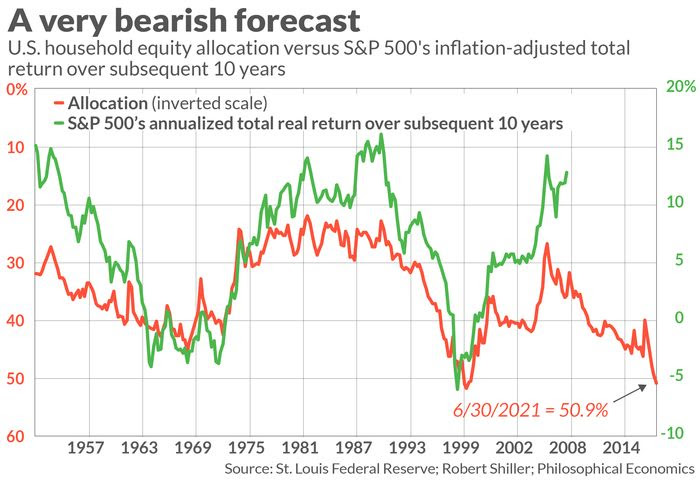
All Fundamental Factors in 95th Percentile Expensive
|
Latest |
End of last month |
Beginning of year |
Percentile since 2000 (100 most bearish) |
Percentile since 1970 (100 most bearish) |
Percentile since 1950 (100 most bearish) |
|
|
P/E ratio |
28.03 |
28.49 |
39.90 |
78% |
88% |
91% |
|
CAPE ratio |
38.34 |
38.09 |
33.76 |
100% |
96% |
97% |
|
P/Dividend ratio |
1.35% |
1.35% |
1.58% |
97% |
95% |
96% |
|
P/Sales ratio |
3.19 |
3.24 |
2.76 |
100% |
100% |
100% |
|
P/Book ratio |
4.74 |
4.82 |
4.05 |
99% |
97% |
97% |
|
Q ratio |
2.37 |
2.41 |
1.98 |
99% |
100% |
100% |
|
Buffett ratio (Market cap/GDP ) |
2.01 |
2.06 |
1.82 |
99% |
100% |
100% |
|
Average household equity allocation |
50.9% |
49.5% |
47.6% |
99% |
99% |
99% |
Mark Hulbert is a regular contributor to MarketWatch. His Hulbert Ratings tracks investment newsletters that pay a flat fee to be audited. He can be reached at mark@hulbertratings.com.
5.Margin Debt+8% to New Record.
Advisor Perspectives

Right Now Margin Debt Increasing at Same Level as Market….See 2000 and 2007 on chart Margin Debt Increased at Much Higher Rate.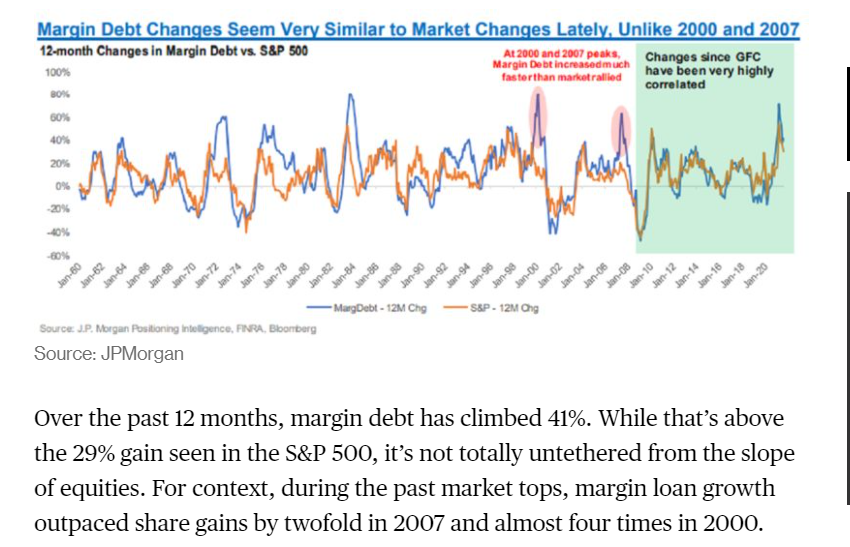
https://www.bloomberg.com/?sref=GGda9y2L
6.Options Record by Retail …Notional Option Value Traded 2021 Higher than Stock Market Volume Traded.
WSJ-Nine of 10 of the most-active call-options trading days in history have taken place in 2021, Cboe Global Markets data show. Almost 39 million option contracts have changed hands on an average day this year, up 31% from 2020 and the highest level since the market’s inception in 1973, according to figures from the Options Clearing Corp.
So far this month, single-stock options with a notional value of roughly $6.9 trillion have changed hands, well above the $5.8 trillion in stocks that traded, according to Cboe data through Sept. 22. Notional value is a measure of how much the shares underlying option contracts are worth, a figure that fluctuates with daily moves in the shares.
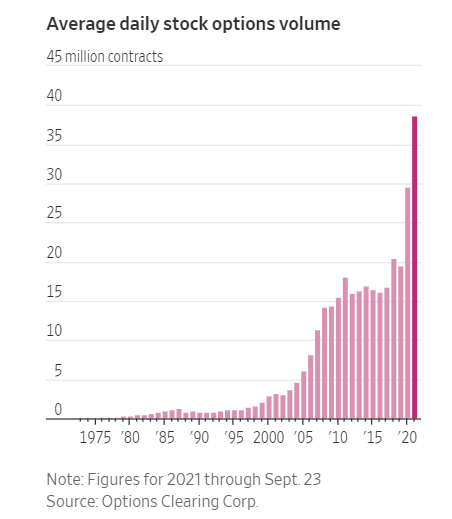
By
Gunjan Banerji https://www.wsj.com/articles/
7.Real Chinese Risk …Economic Slowdown vs. Credit Crisis?
The August data already showed a decline in year-on-year retail sales growth from 8.5% in July to 2.5%, though this partly reflected the effects of anti-Covid restrictions. That slowdown seems likely to persist through September and October.
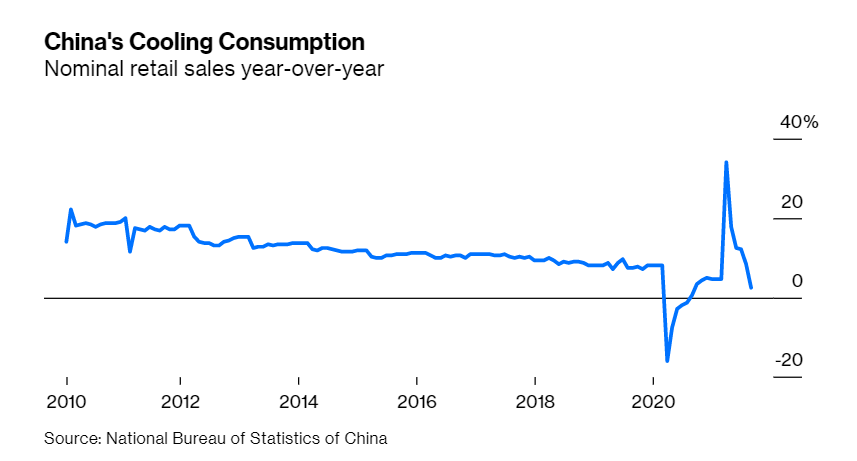
China’s Tightening Grip
·
-
- Xi’s Warning: A century after the Communist Party’s founding, China’s leader says foreign powers would “crack their heads and spill blood” if they tried to stop its rise.
- Behind the Takeover of Hong Kong: One year ago, the city’s freedoms were curtailed with breathtaking speed. But the clampdown was years in the making, and many signals were missed.
- One Year Later in Hong Kong: Neighbors are urged to report on one another. Children are taught to look for traitors. The Communist Party is remaking the city.
- Mapping Out China’s Post-Covid Path: Xi Jinping, China’s leader, is seeking to balance confidence and caution as his country strides ahead while other places continue to grapple with the pandemic.
- A Challenge to U.S. Global Leadership: As President Biden predicts a struggle between democracies and their opponents, Beijing is eager to champion the other side.
- ‘Red Tourism’ Flourishes: New and improved attractions dedicated to the Communist Party’s history, or a sanitized version of it, are drawing crowds ahead of the party’s centennial.
https://www.nytimes.com/2021/
8.Land Prices for New Homes +16% Year Over Year
John Burns Real Estate
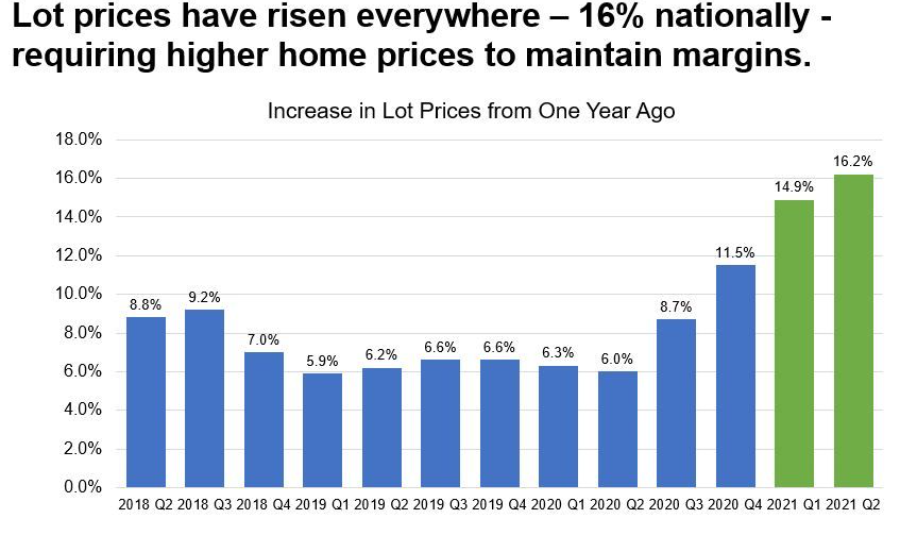
https://www.linkedin.com/in/johnburns7/
9.Wes Gray Alpha Architects
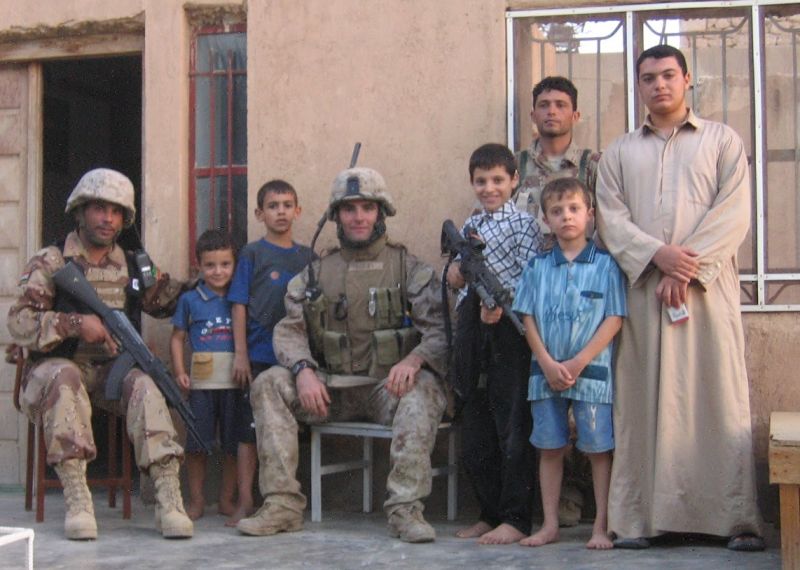

First LT Nathan Krissoff was my roommate in the #USMC and his teachings saved my life a few months prior to his death.
Krissoff was a human intelligence officer (HUMINT) and a savant when it came to understanding what makes people tick. Krissoff would always say the same thing: ” Gray. You are overthinking it. Be kind. Build rapport; save lives.”
Fast forward to late 2006 when we were both forward deployed to Al Anbar Province — Krissoff was in Fallujah; I was in Haditha.
I was on patrol with an Iraqi squad in the palm groves along the Euphrates. We were setting up sniper overwatch positions to watch for IED placements.
Part of our mission involved asking…okay, let’s be honest…demanding…that a local family grant us access to their roof. The last thing anyone wants is a bunch of knuckleheads with loaded weapons crashing their house and using their roof as an overwatch position. But it was the only secure option that provided clear overwatch on the main road through town.
Krissoff’s teaching rang in my head — Be kind. Build rapport; save lives. Sure, we could push the local Iraqis around and do whatever we wanted. But that wasn’t kind, wasn’t going to build rapport, and wasn’t going to save lives. So I let my guard down a bit and struck up a conversation with the residents of the home and let the Iraqi kids check out all of my gear/weapons/etc.
After 3 hours of chit-chat with my new Iraqi friends, we rallied the patrol to head back to the base. But before we left the house, one of the Iraqi soldiers sent several of the kids out to go buy a pack of cigarettes. The kids returned in a cold sweat eager to catch my attention. “There is an armed insurgent ambush waiting for you inside the market. We’ll take you out the back of the house so you can sneak into the palm groves.”
YIKES.
We thanked the children profusely and took their advice and backtracked back to base via the palm groves — avoiding a violent and unfair gunfight along the way.
Krissoff’s mantra can be applied in a lot of aspects outside of human intelligence and combat operations. This lesson is really the Golden Rule: Treat others like you’d want to be treated. A simple concept that can lead to better business relationships, more friendly social interactions, and an evergreen sense of empathy for other humans.
10.Great Leaders Are Thoughtful and Deliberate, Not Impulsive and Reactive
by Tony Schwartz and Emily Pines
HBR
You set aside the first hour of your day to work on a strategy document that you’ve been putting off for a week. You haven’t been disciplined about getting to it, but you’ve had one crisis after another to deal with in the past week. Now, finally, you’ve carved out 90 early morning minutes to work on it.
First, however, you take a quick peek at the email that has piled up in your inbox overnight. Before you know it, you’ve used up the whole 90 minutes responding to emails, even though none of them were truly urgent.
By the time you walk into your next meeting, you’re feeling frustrated that you failed to stick by your plan. This meeting is a discussion with a direct report about the approach he’ll be taking in a negotiation with an important client. You have strong views about how best to deal with the situation, but you’ve promised yourself that you will be open and curious rather than directive and judgmental. You’re committed, after all, to becoming a more empowering manager.
Instead, you find yourself growing even more irritable as he describes an approach that doesn’t feel right to you. Impulsively, you jump in with a sharp comment. He reacts defensively. You worry for a moment — and rightly so — that you cut him off too quickly, but you tell yourself that you’ve worked with this client for years, the outcome is critical, and you don’t have time to hear your direct report’s whole explanation. He leaves your office looking hurt and defeated.
Welcome to the invisible drama that operates inside us all day long at work, mostly outside our consciousness. Most of us believe we have one self. In reality, we have two different selves, run by two separate operating systems, in different parts of our brain.
The self that we’re most aware of — the one that planned to work diligently on the strategy document and listen patiently to your direct report — is run by our pre-frontal cortex and mediated through our parasympathetic nervous system. This is the self we prefer to present to the world. It’s calm, measured, rational, and capable of making deliberate choices.
The second self is run by our amygdala, a small almond-shaped cluster of nuclei in our mid-brain and it is mediated by our sympathetic nervous system. Our second self seizes control any time we begin to perceive threat or danger. It’s reactive, impulsive, and operates largely outside our conscious control.
This second self serves us well if a lion is coming at us, but the threats we experience today are mostly to our sense of worth and value. They can feel nearly as terrifying as those to our survival, but the danger we experience isn’t truly life-threatening. Responding to them as if they are only make things worse.
It’s in these moments that we often use our highest cognitive capacities to justify our worst behaviors. When we feel we’ve fallen short, we instinctively summon up our “inner lawyer” — a term coined by author Jonathan Haidt — to defend us.
Our inner lawyer is expert at rationalizing, avoiding, deflecting, dissembling, denying, disparaging, attacking, and blaming others for our missteps and shortcomings. The inner lawyer works overtime to silence our own inner critic, and to counter criticism from others. All this inner turmoil narrows and consumes our attention and drains our energy.
The problem is that most organizations spend far more time focused on generating external value than they do attending to people’s internal sense of value. Doing so requires navigational skills that most leaders have never been taught, much less mastered. The irony is that ignoring people’s internal experience leads them to spend more energy defending their value, leaving them less energy to create value.
In our work with leaders, we’ve discovered that the antidote to reacting from the second self is to develop the capacity to observe our two selves in real time. You can’t change what you don’t notice, but noticing can be a powerful tool for shifting from defending our value to creating value.
A well-cultivated self-observer allows us to watch our dueling selves without reacting impulsively. It also makes it possible to ask our inner lawyer to stand down whenever it rises up to argue our case to our inner and outer critics. Finally, the self-observer can acknowledge, without judgment, that we are both our best and our worst selves, and then make deliberate rather than reactive choices about how to respond in challenging situations.
To improve your capacity to self-observe, begin with negative emotions such as impatience, frustration, and anger. When you feel them arising, it’s a strong signal that you’re sliding into the second self. Simply naming these emotions as they arise is a way to gain some distance from them.
Also, watch out for times when you feel you’re digging in your heels. The absolute conviction that you’re right and the compulsion to take action are both strong indicators that you‘re feeling a sense of threat and danger.
In our work, we provide leaders with small daily doses of support — reminders to pay attention to what they’re feeling and thinking. We’ve also found it helpful to build small groups that meet at regular intervals so leaders can share their experiences. A blend of support, community, connection and accountability helps offset our shared impulse to stop noticing, push away discomfort, and revert to survival behaviors in the face of perceived threats to our value. A good starting place is to find a colleague you trust to be your accountability partner, and to seek regular feedback from one another.
Finally, it’s important to ask yourself two key questions in challenging moments: “What else could be true here?” and “What is my responsibility in this?” By regularly questioning your conclusions, you’re offsetting your confirmation bias — the instinct to look for evidence that supports what you already believe. By always looking for your own responsibility, you’re resisting the instinct to blame others and play victim and focusing instead on what you have the greatest ability to influence — your own behavior.
A deceptively simple premise lies at the heart of this deliberate set of practices: see more to be more. Rather than simply getting better at what they already do, transformational leaders balance courage and humility in order to grow and develop every day.